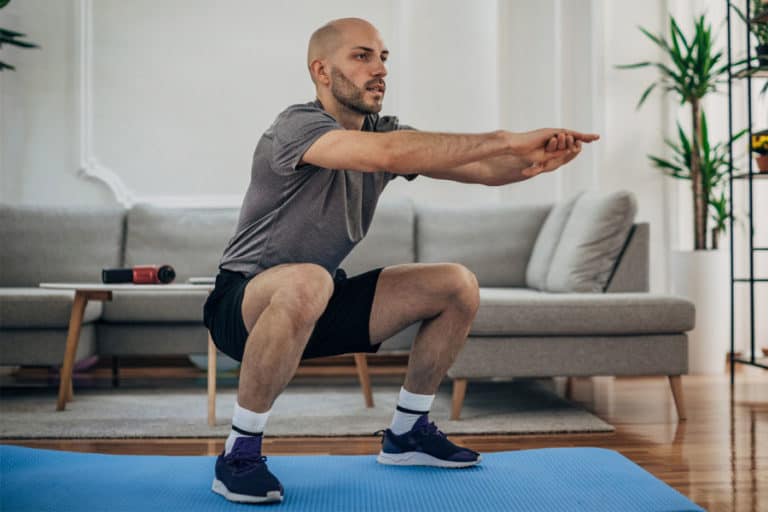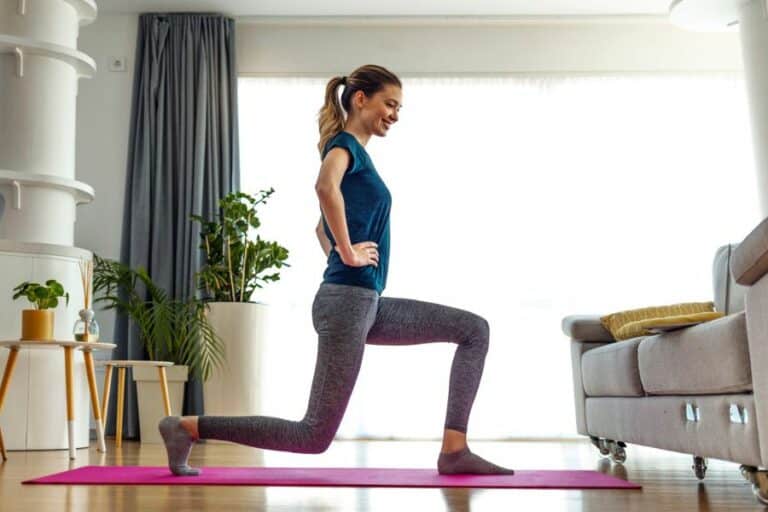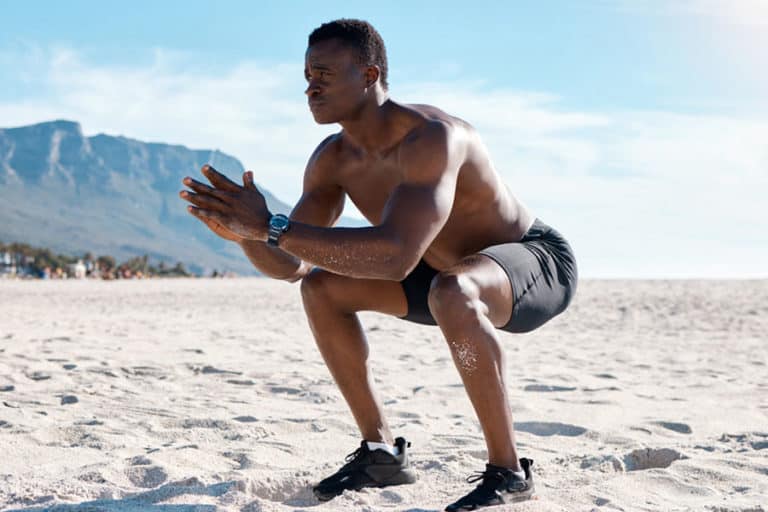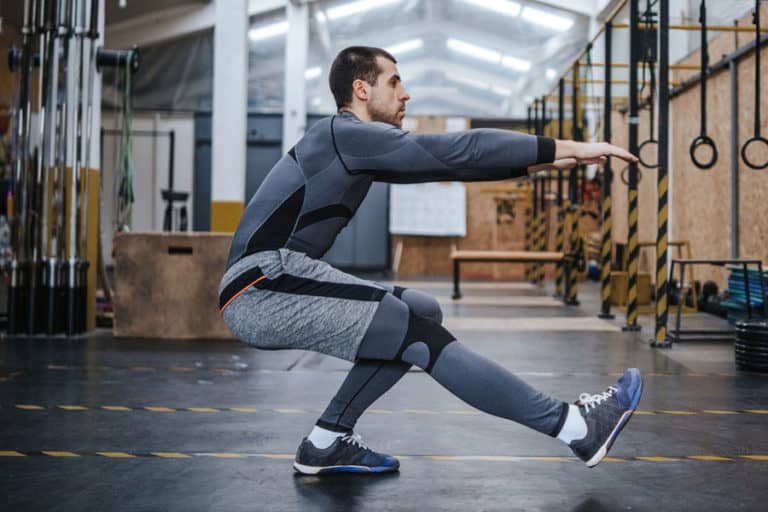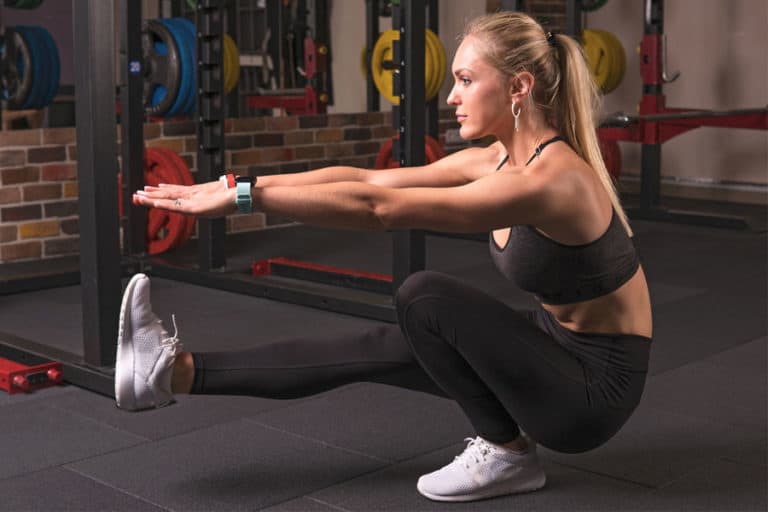Hip Hinge Exercises – Techniques, Benefits, Variations
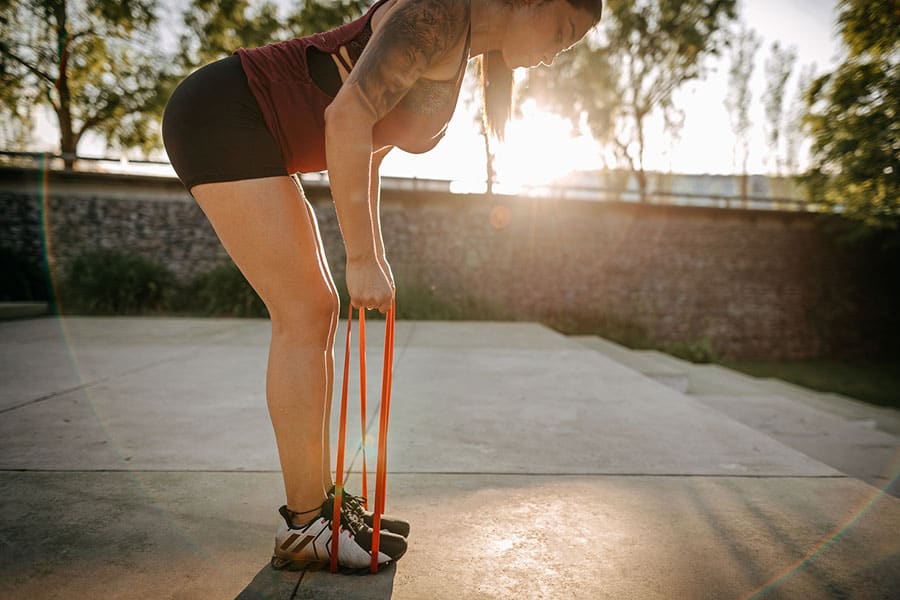
How to do | hip hinge muscles worked | Hip Hinge Variations | Tips | Who Should Not Do | Common Mistakes | FAQs
The hip hinge movement is extremely necessary for improving physical performance. You may not know it, but you hinge a lot. For example, when you sit, climb the stairs, get out of bed, bend to pick something, or bend to get up from a chair, that’s what you’re doing.
Being intentional with this movement will help with your flexibility and improve your posterior chain, including your important muscle groups like the lower back, glutes, and hamstrings. It also helps improve your physical activities, including building strength for your workout routines. Hence, the need to get better at your hip hinge exercises.
However, it’s more serious than bending to pick up something. Read on to learn about hip hinge techniques and variations.
How to do hip hinge exercise?
Hip hinge is a fundamental movement pattern in fitness and workouts. These exercises help improve your movement, posture [1]U.S. Department of veterans affairs: Body Mechanics and the Hip Hinge and strength. Additionally, it can help you move better and faster because you’re using your hips more efficiently.
Here is a step by step guide to performing it:
- To do a basic hip hinge, with your feet apart at an appropriate width, hold a neutral spine position, bend your knees, brace your core muscles, and push your hips.
- To ensure that you are doing it the right way, you can use a dowel rod.
- Place the rod vertically across your back, ensuring it is constantly in contact with your lower back.
- Grip the top of the dowel with one hand near the neck and the other at the bottom of the dowel, at the base of your spine. This will help you maintain the lordotic curve in your lower back as you hinge forward.
- As you push your hips back, keep the dowel in place by contracting your glutes. You should feel a stretch in your hamstrings as you lower your torso.
- When you reach the end range of motion, squeeze your glutes, and return to the starting position. The dowel rod will help you maintain alignment and balance.
Watch the video below for a demonstration of the hip hinge exercise. This exercise can be a valuable addition to your fitness routine for consistent progress. As you gain proficiency with the exercise, you can push yourself further by trying out more challenging variations.
What muscles does the hip hinge work?
The hip hinge exercise is primarily a posterior chain exercise, which means that the primary muscles worked are located on the back of the body. The main muscles worked in the hip hinge exercise include:
Primary Muscles:
- Glutes (especially the gluteus maximus)
- Hamstrings
- Erector spinae (muscles that run alongside the spine)
- Lower back muscles
These muscles work together to perform the hip hinge movement and are responsible for extending the hips and maintaining a neutral spine.
Secondary Muscles:
- Core muscles (including the transverse abdominis and obliques)
- Quadriceps (front of the thighs)
- Adductors (inner thigh muscles)
- Calves (gastrocnemius and soleus)
These muscles provide additional support and stabilization during the exercise, but are not the main focus of the movement.
9 hip hinge exercises – Variations
If you do not master the hip hinge motion, you may find it hard to do the related exercises. You need a well-defined and correctly done basic hip hinge movement to execute many strength training exercises in the right way.
To make it easy for you, we have listed 9 hip hinge exercises and variations, including basic hip hinge, you can try:
1. Hip Hinge Wall Touches
Target muscles: Glutes, hamstrings, and lower back
How to do
- Position yourself with your feet shoulder-width apart and back flat against a wall at a gap of at least 3 inches.
- Bend your knees and push your hips back, moving your butt towards the wall.
- Once your hips are in line with your knees and touch the wall, stop and hold for a moment.
- Return to the starting position by pushing your hips forward and straightening your knees.
- Repeat the steps.
Summary: This is one of the easy variations of Hip Hinge exercises. The beauty of using wall support for this drill is that the wall acts as an external target to keep you in check about where the movement needs to start and end. This exercise will help you understand your hip motion better. Upon mastering this, you can try advanced variations.
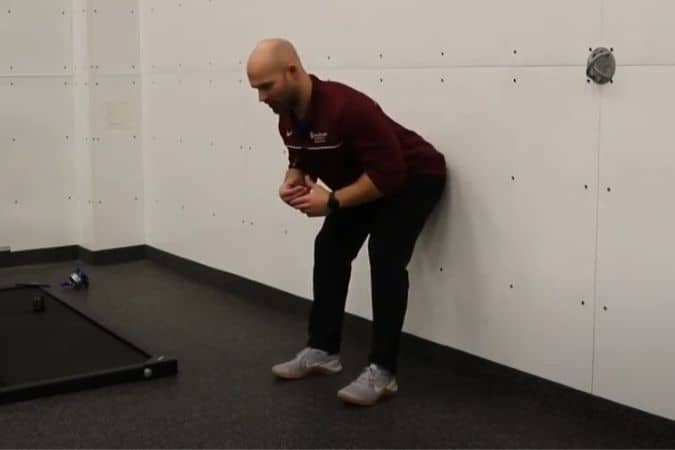
2. Conventional deadlifts
Target muscles: Hamstrings, glutes, and trapezius.
How to do
- Stand with your feet apart at a slightly wider shoulder-width distance. Put your barbell on the floor and let your toes be under the bar.
- Squat to hold the bar with a shoulder width overhand.
- Brace your core, straighten your arm, raise your chest and lower your hips.
- Stand firm as you stand up and hold the barbell close to your legs.
- Stand upright and lower the barbell back to the floor.
- Let the barbell be for a few seconds; relax your core and grip. Then repeat the process.
Summary: This variation starts with a hip hinge extension rather than hip flexion. This exercise is very productive and helps strengthen your core, boost your metabolism, improve your performance, and reduce lower back pain. You can build muscles, strength, and overall athletic performance.

3. Romanian deadlift
Target muscles: Glutes, adductors, grip, and trapezius.
How to do
- Grab dumbbells in both hands or a barbell right in front of your thighs.
- Stand keeping your feet apart at hip width and bend your knees slightly.
- Lean your shoulder downward and brace your core.
- Look straight.
- Hinge your hips back and lean forward.
- Lower the dumbbells or barbell close to the front of your legs as much as your hamstrings can stretch.
- Push your hips forward and stand up. Repeat the process.
Summary: Romanian deadlifts differ slightly from deadlifts because the weight doesn’t touch the ground. To execute this exercise, you must complete your hip hinge movement downward and grip the weights. It is one of the best hip hinge exercises to try. It also helps to boost your strength and improve your balance and coordination.
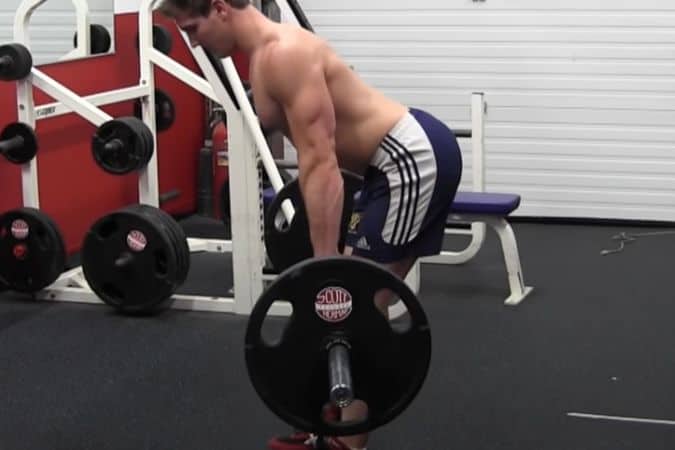
4. Kettlebell deadlifts
Target muscles: Quadriceps, glutes, and hamstrings.
How to do
- Stand with your feet shoulder-width apart, rotate your feet internally, and point your toes slightly out. Place the kettlebell between your ankles on the ground.
- Inhale and brace your core, then hinge your hips backward.
- Reach for the kettlebell, grab it with both hands and pull until you feel your adductors and hamstrings strengthen.
- Push your hips forward till full extension and close your glutes till you pull the kettlebell up.
- Breathe out at the top of the movement while holding the kettlebell between your legs.
- Brace your core while returning to the starting position and hinge your hip back to return the kettlebell to the ground.
Summary: Kettlebell deadlifts are effective workout routines and can serve as a hip hinge exercise. This exercise helps to strengthen your lower and upper body muscles. It works mainly on the backline muscles and builds strength, power, balance, and body posture. It also improves bone density and cardiovascular fitness. To improve balance, you can take support of the wall.

5. Cable pull through
Target muscles: Glutes and hamstrings.
How to do
- Fasten a rope handle to a low pulley machine.
- Stand feet apart with your back to the machine and stride the rope handle.
- Hold the handle with both hands and step forward to tension the cable.
- Bend your knees, and pull your shoulders back while bracing your core.
- Hinge your hips, push your butt backward, and be careful not to round your lower back.
- Push your hips forward, stand right, and repeat.
- You can modify it with a resistance band.
Summary: Cable pull-through hip hinge variation is lower back-friendly, and it’s good for beefing up the lower body. It helps promote general muscle growth. It also helps you perfect your hip movement, just like other exercises like barbell hip thrust and Kettlebell Romanian deadlift.
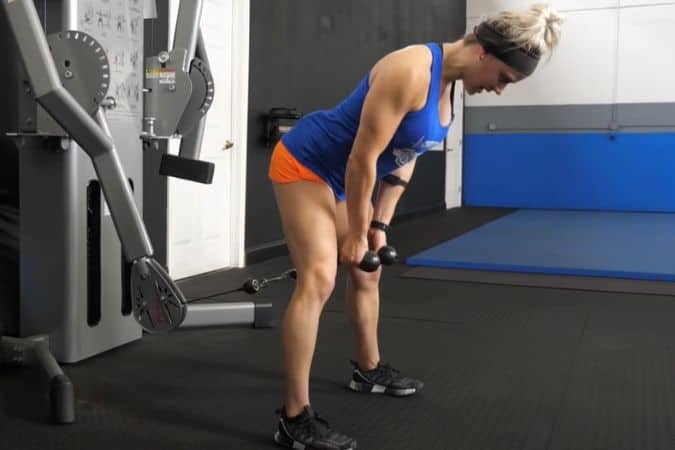
6. Barbell good mornings
Target muscles: Hamstrings, back, glutes, and abs.
How to do
- Hold a barbell over your upper back.
- Adjust the bar to hold it in place.
- Brace your core and stand, keeping your feet at hip-width apart.
- Slightly bend your knees.
- Hinge your hip back and lean forward.
- Lower your chest.
- Push your hips forward and stand.
Summary: This exercise got its name from the head movement, which seems like you’re bowing to greet someone. The variation is similar to Romanian deadlifts.

7. Resistance band hip hinge
Target muscles: Glutes and hamstrings.
How to do
- Stand up with your feet at a hip-width distance.
- Step on the center of an unlooped resistance band.
- Hold both ends, each in one hand.
- Keeping your feet firm and planted on the floor.
- Bend your knees slightly.
- Hinge at the hips, push your butt back and lower your torso until you feel stretch in your hamstring and glutes.
- Hold the position for a few seconds.
- Return to the starting position.
Summary: This exercise targets your glutes and hamstrings and is lower back friendly. This hip hinge benefits your muscles by strengthening them and it also maximizes weight loss.
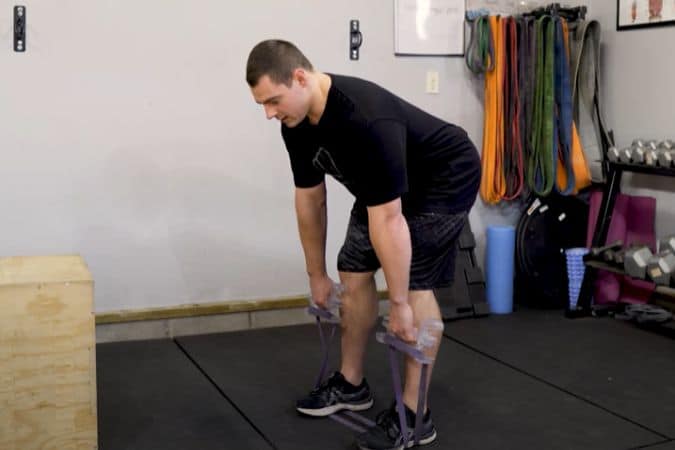
8. Kettlebell twisting hip hinge
Target muscles: Obliques, glutes, and hamstrings.
How to do
- Start by standing with your feet shoulder-width apart.
- Grab the kettlebell with both your hands and hold it by horns close to your chest.
- Ensure the base of the kettlebell ball is touching your chest and elbows facing outwards.
- Now hinge forward as you twist your torso towards the right keeping your back straight, core engaged, your left knee slightly bent, and your right leg feeling the stretch in the hamstring.
- That is, your left shoulder moves downwards towards your right knee and vice versa.
- Move back to the start position and continue the same on the other side without putting the kettlebell down.
Summary: This variation of the hip hinge, the twisting motion works a group of muscles together. It is not only a dynamic exercise to include in your routine but also will allow you to get a good stretch. Moreover, it will also help you improve your flexibility and relieve stiffness in your obliques.
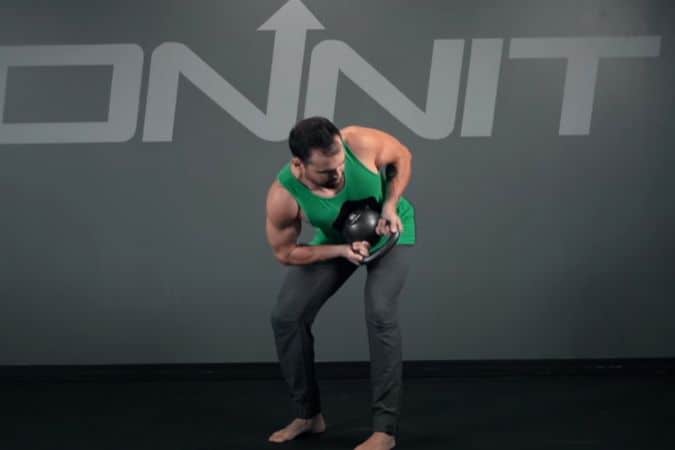
9. Kettlebell swings
Target muscles: Hamstrings, glutes, spinal erectors, and upper back.
How to do
- Grab a kettlebell in your hands and hold it in front of your hips.
- Stand with your feet slightly more than hip-width apart, dip a little with a slight bend of the knees.
- Pull your shoulders down and back simultaneously as you brace your core.
- Thrust your hips backward and lower the kettlebell down between your knees.
- Refrain from rounding your lower back.
- To start executing the swing, push your hips back, bend forward first, and then hinge forward to swing the kettlebell to shoulder height.
- Maintain straight arms all through.
- Lower the kettlebell to the ground again and repeat.
Summary: The kettlebell swing is a hip-dominant workout. This exercise requires you to execute the move through controlled hip hinge movement. It helps to build strength which you can transfer to your other athletic activities. In addition, kettlebell swings can help you lose weight, strengthen your muscles, improve your posture, and boost your cardio fitness. If you do not have a kettlebell available, you can try doing a dumbbell swing.
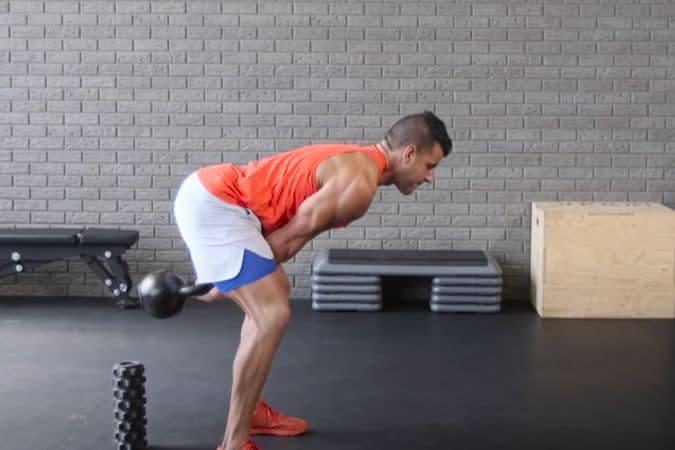
Tips to follow before doing a hip hinge exercise
You need to do the hip hinge exercise correctly to prevent any injury or pain and get your desired results. Posture matters with this workout routine. Here are the tips to remember when doing hip hinges:
- Bend till you feel stretching in your muscle.
- Your stance should be right with your feet shoulder-width apart.
- Move from the hip.
- Remember to brace your core.
- Keep your shoulders back.
- Move hips back.
Who should not do hip hinge exercises?
Generally, hip hinge exercises are good for your body. They offer many benefits, including strengthening your muscles, metabolism, weight loss, and so many other benefits.
However, some hip hinge exercises can be hard on the back and bad for people with back pain. However, it can help to treat low back pain, but it has to be gradual and not immediate.
You can try variations using the wall, a plank, or a ball. People with bone problems should also consult their doctors before starting hip hinge exercise.
Common mistakes to avoid while doing hip hinge exercises
The hip hinge is a fundamental movement pattern, but many people make mistakes when performing it, which can lead to injury or reduced effectiveness of the exercise.
- Rounded back: Avoid rounding your back during the hip hinge movement to prevent injury.
- Poor hip mobility: Work on improving your hip mobility to ensure proper range of motion during the hip hinge.
- Lack of glute engagement: Make sure to activate your glutes and hamstrings during the hip hinge, not just your lower back.
- Overextending: Avoid overextending at the top of the movement to prevent hyperextension of the spine.
- Starting with knees: Initiate the hip hinge by pushing your hips back, not by bending your knees, to avoid undue stress on the knees.
Conclusion
Hip hinge exercises are very beneficial. Practicing smooth and controlled hip hinge movement ensures better hip mobility, posture, and core stability. Due to the important stabilization muscles involved in executing the basic hip hinge movements, they help you with balance and proper posture.
Moreover, you need them for all your other physical activities. Since many strength exercises like the kettlebell swing, dumbbell-based deadlifts, and so on involve hip hinging, it is always a good idea to master the technique of proper hip hinging.
While the basic hip hinge movement looks simple and uncomplicated, it isn’t exactly so. It is essential to perform hip hinge-based exercises under a certified physical trainer’s guidance and careful supervision. Also, ensure you warm up and cool down to avoid injuries. Consult your doctor immediately if you encounter any pain or discomfort after your hip hinge workout.
FAQs
What are hip hinges good for?
Hip hinges are excellent for strengthening the posterior chain muscles, including the glutes, hamstrings, and lower back. They also improve hip mobility and overall athleticism, making them a valuable addition to any strength training program.
What is basic hip hinge movement?
The basic hip hinge movement involves bending at the hips while keeping a neutral spine and maintaining a slight bend in the knees. It is used in exercises such as deadlifts and kettlebell swings to target the posterior chain muscles.
Is hip thrust a hinge exercise?
Yes, the hip thrust is a hinge exercise that targets the glutes and hamstrings. It involves extending the hips while maintaining a neutral spine and can be performed with various equipment, including a barbell, dumbbell, or resistance band.
What is a hinge lift?
A hinge lift is a term used to describe exercises that involve a hip hinge movement, such as deadlifts, kettlebell swings, and Romanian deadlifts. These exercises target the posterior chain muscles and are an effective way to build strength and improve athletic performance.
What is a hip hinge?
A hip hinge is a movement pattern where you bend forward from your hips while keeping your spine straight and your knees slightly bent. It is commonly used in exercises like deadlifts, kettlebell swings, and Romanian deadlifts.
References
| ↑1 | U.S. Department of veterans affairs: Body Mechanics and the Hip Hinge |
|---|


